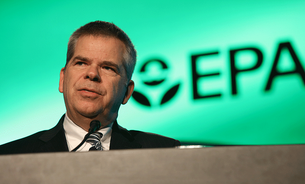EPA review seeks array of data

Speaking Tuesday at the CAR Management Briefing Seminars, Christopher Grundler, director of the EPA’s Office of Transportation and Air Quality, said the review will incorporate test data to a greater extent than ever.
The review is due by April 1 and could change the 50.8 mpg fleetwide average fuel economy goal enacted Jan. 13 in the final days of the Obama administration.
Some feel the fuel economy standard was rushed through without proper vetting in order to secure the outgoing president’s legacy on the environment. In March, the Trump administration ordered the EPA to reopen the midterm review.
Grundler said engineers working at the EPA’s Ann Arbor, Mich., emissions lab will tear down and benchmark a greater number of powertrains this time, including a diesel engine, a 10-speed transmission, a downsized and turbocharged engine and Toyota’s new 2.5-liter four-cylinder that had a thermal efficiency rating at 41 percent.
There will be another new twist this time, he revealed: The EPA will buy consumer data that quizzes new-vehicle buyers on such things as their satisfaction with their real-world fuel economy.
As part of the drive to collect new data, Grundler said, EPA officials are working with automakers, suppliers, the California Air Resources Board and government agencies in Europe and China.
"We are also stepping up our work to test vehicles once they are in customers’ hands. We’re developing new screening methods to ensure these engines are behaving in the real world in a correlated manner when we test them in the laboratory, so we no longer have defeat-device cases to pursue,” said Grundler.
In February, the Alliance of Automobile Manufacturers, representing the Detroit 3 and several import brands, asked the Trump administration to reopen the review of the 2025 model year standards. Automakers felt the adoption of the goals was rushed to cement Obama’s legacy on the environment. Former EPA administrator Gina McCarthy finalized the 2025 model year standards on Jan. 13, some 15 months before April 1, 2018, the latest date the EPA could accept, reject or adjust the 2022-25 model year standards.
That April 1, 2018, date has been restored.
EPA researchers are gathering new data that will help determine if fleet average fuel economy should stay at 50.8 mpg or be rolled back.
The original standard called for the equivalent of 54.5 mpg by the 2025 model year, but surging demand for less fuel efficient pickups and SUVs lowered the 2025 fleet average to 50.8. The standard is written to be adjustable to take into account the mix of vehicles sold.
Grundler said the EPA is ensuring that its testing methods are uniform across all its labs and that the data are certified by other labs as being accurate. He also said the EPA is working to streamline and simplify the confusing labyrinth of rules, regulations and laws that govern fuels.
"The midterm review is another golden opportunity for us to rethink how well the regulations are working and to improve them,” Grundler said. "You have heard me say from this exact podium that with all the changes going on in this business, we in the public sector ought to be willing to rethink and change the way we do business and how we are approaching this, and I still believe that.”
One change this time is that the EPA is buying consumer data from a company that surveys new-car buyers, although Grundler did not identify the company. However, he cited examples of questions that were similar to the consumer fuel economy questions normally asked on J.D. Power’s Initial Quality Survey.
"We pledged that this will be a robust, transparent and inclusive process, and the main goal is to allow more time to gather more information, more up to date information and to allow us more time to coordinate with NHTSA and what we are doing,” he said.
Grundler’s message this year did not focus on CO2 levels, which were the centerpiece of his presentation at the seminars last year.
"Elections do have consequences and politics are changing and will continue to change. That’s part of American democracy,” he said. "But one thing is constant, and that’s the mission of the Environmental Protection Agency, to protect public health and the environment because that is rooted in the law.
"Our job remains to provide the best technical advice, scientific advice and what the law says to our political leadership.”
Source: Automotive News


